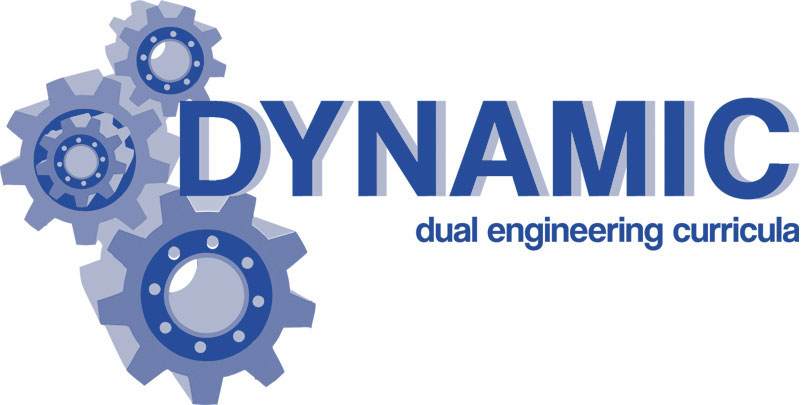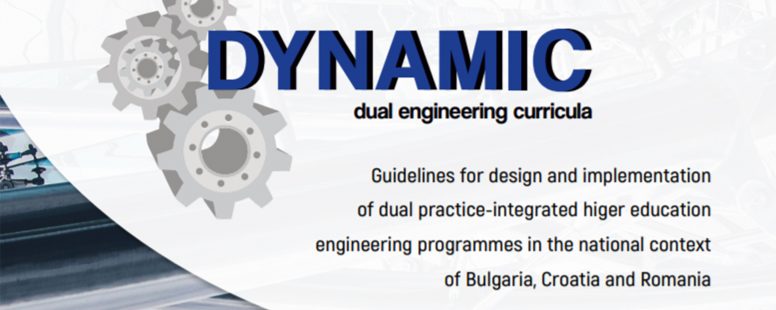Methodical Guidelines for design and implementation of dual practice-integrated higher education engineering programmes in the national context of Bulgaria, Croatia and Romania, prepared within the Dynamic project are online in 4 language versions – English, Bulgarian, Romanian and Croatian.
In the context of a rapidly evolving world, university graduates need the appropriate competences to manage the changes, complexities and uncertainty of the modern world of work. Requirements of employment and the workplace reflect advancements in knowledge and innovation being adopted by companies and the economy. Designing sustainable and practical solutions to equip students with employability and entrepreneurial skills requires a dialogue between academia and business. Finding space in the academic curricula to embed topics with relevance to the global labour market challenges can be addressed by mutually beneficial cooperation between these two stakeholder groups. The direct involvement of industry stakeholders in the curriculum design and delivery is seen as an opportunity to keep certain study programmes closely relevant to the needs of the labour market. This objective is best materialised by the dual system of education. The integration of regular practical incompany phases in study programmes makes curricula more flexible and responsive to the current industrial and technological developments. The advantages of the dual system of education are innumerable. They are not specific to engineering studies but are particularly relevant to this field.
The methodological document aims to highlight the successful engagement experience between universities and industrial companies in three EU Member States: Bulgaria, Romania and Croatia. Within the project DYNAMIC, academic and industrial experts came together to jointly design and implement practice-integrated dual higher education models that are feasible for the country-specific conditions and regional needs. The Guidelines serves the purpose to evidence the benefits of dual higher education for the flexibilization and modernisation of engineering curricula. It demonstrates a functional methodology for the modification of existing academic programmes and their realignment with current industry needs. Finally, the document aims to highlight the good practices with a high degree of transferability to other institutions, partnerships, thematic areas or curricular settings and promote the upscaling of dual higher education across Europe.
The methodological framework of the Guidelines is based on empirical data collection through qualitative methods. During the evaluation process, a content analysis of project documentation and partners’ reports has been applied in regular terms. For the data validation and extraction of lessons learnt interviews with individual partners as well as peer reviews with the participation of the main stakeholder groups have been conducted. The evaluation results provide the groundwork for the formulation of the present Guidelines and pay particular attention to elements with high transferability potential in similar institutional and country specific settings. Therefore, the primary aim of these Guidelines is to support curriculum developers and faculty members in the partner and further higher education institutions involved in the development of practice-orientated education. In the medium term, the Guidelines intend to promote the scalability of the dual higher education model in Bulgaria, Romania and Croatia and contribute to the development of more practice-integrated dual higher education programmes. In addition, the Guidelines aim to support academic staff in supervising positions, HR managers and industrial mentors in companies interested in active talent development and, last but not least, researchers in the field of vocational education and training, professional education, and comparative education systems.
The Guidelines are structured in 11 chapters altogether. The first one presents the dual study model applied in higher education in Germany and Austria, where this model has been in practice for a long time now. Practical examples for dual higher education programmes in Germany and Austria are provided by the DYNAMIC partners – the University of Applied Sciences Wismar and University of Applied Sciences Joanneum. The second chapter investigates the transferability of the model identifying adaptive elements from the German and Austrian systems that are applicable to the national settings of Bulgaria, Romania and Croatia. Chapter 3 describes the context of curricula development by highlighting the common prerequisites resulting from the European cooperation in higher education; it also points out the limitations resulting from the specifics of the national higher education systems. Chapter 4 describes the approaches of curriculum development or curriculum adaptation for dual implementation followed by the partners in each country. Chapter 5 is devoted to the curriculum implementation. Consequently, chapters 6 and 7 are targeted at the academic and industry mentors by providing useful information on further qualification options and lessons shared by the mentors who have gained first experience with dual education within the DYNAMIC project. The next three chapters discuss on the lessons learnt from the implementation of the dual higher education pilot models, the impact expected in the long term as well as the implications for European cooperation in dual higher education. Finally, chapter 11 provides a brief outlook for further cooperation.
The Guidelines are available for download on the Dynamic Project website in all 4 language versions. Link for download: https://dynamic-project.eu/activities/ – WP6: Methodological guidelines for design and implementation of dual practice-integrated higher education programmes in Science & Technology Studies

